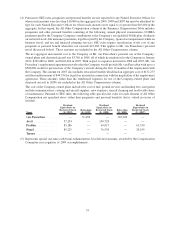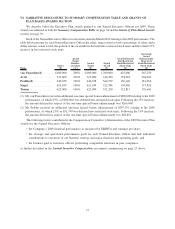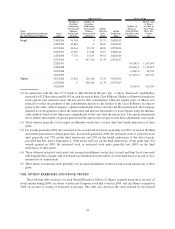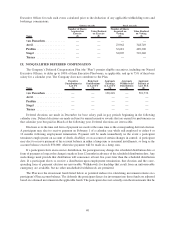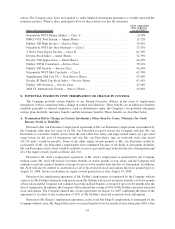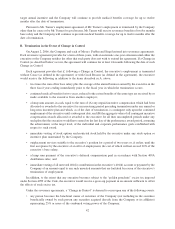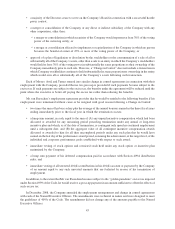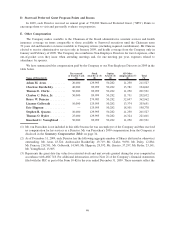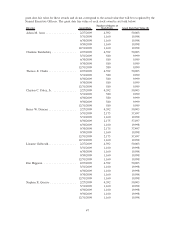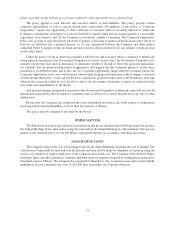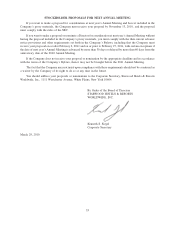Starwood 2009 Annual Report Download - page 54
Download and view the complete annual report
Please find page 54 of the 2009 Starwood annual report below. You can navigate through the pages in the report by either clicking on the pages listed below, or by using the keyword search tool below to find specific information within the annual report.such severance pay and other benefits. Because of Mr. van Paasschen’s recent hire, his base period taxable
compensation does not reflect the total compensation paid to him, artificially increasing the excise tax that
would apply on a change in control and, correspondingly, the tax gross-up payment due under the estimate.
XI. DIRECTOR COMPENSATION
The Company uses a combination of cash and stock-based awards to attract and retain qualified candidates to
serve on the Board. In setting Director compensation, the Company considers the significant amount of time that
members of the Board spend in fulfilling their duties to the Company as well as the skill level required by the
Company or its Directors. The current compensation structure is described below.
For 2009, under the Company’s Director share ownership guidelines, each Director was required to own Shares
(or deferred compensation stock equivalents) that have a market price equal to two times the annual Director’s fees
paid to such Director. In February 2010, the Board approved an increase in the share ownership guidelines in that
each Director is required to own Shares (or deferred compensation stock equivalents) that have a market price equal
to four times the annual Director’s fees paid to such Director. If any Director fails to satisfy this requirement, sales of
Shares by such Director shall be subject to a 35% retention requirement. Any new Director shall be given a period of
three years to satisfy this requirement.
Company employees who serve as members of the Board receive no fees for their services in this capacity.
Non-employee members of the Board (“Non-Employee Directors”) receive compensation for their services as
described below.
A. Annual Fees
Each Non-Employee Director receives an annual fee in the amount of $80,000, payable in four equal
installments of Shares issued under our LTIP. The number of Shares to be issued is based on the fair market value of
a Share using the average of the high and low price of the Company’s stock on the previous December 31.
A Non-Employee Director may elect to receive up to one-half of the annual fee in cash and to defer (at an
annual interest rate of LIBOR plus 11⁄2% for deferred cash amounts) any or all of the annual fee payable in cash.
Deferred cash amounts are payable in accordance with the Director’s advance election. A Non-Employee Director
is also permitted to elect to defer to a deferred unit account any or all of the annual fee payable in Shares. Deferred
stock amounts are payable in accordance with the Non-Employee Director’s advance election.
Non-Employee Directors serving as members of the Audit Committee received an additional annual fee in
cash of $10,000 ($25,000 for the chairman of the Audit Committee). The chairperson of each other committee of the
Board received an additional annual fee in cash of $10,000; commencing in 2010, this chairperson additional annual
fee has been increased to $12,500 in cash. The Chairman of the Board received an additional retainer of $150,000,
payable quarterly in restricted stock units which vest in three years.
B. Attendance Fees
Non-Employee Directors do not receive fees for attendance at meetings.
C. Equity grant
In 2009, each Non-Employee Director received an annual equity grant (made at the same time as the annual
grant is made to Company employees) under our LTIP with a value of $100,000. In February 2010, this annual
equity grant value was increased to $125,000. The equity grant was delivered 50% in stock units and 50% in stock
options. The number of stock units is determined by dividing the value by the average of the high and low Share
price on the date of grant. The number of options is determined by dividing the value by the average of the high and
low Share price on the date of grant (also the exercise price) and multiplying by two and one half. The options are
fully vested and exercisable upon grant and are scheduled to expire eight years after the grant date. The restricted
stock awarded pursuant to the annual grant generally vests upon the earlier of (i) the third anniversary of the grant
date and (ii) the date such person ceases to be a Director of the Company.
45


